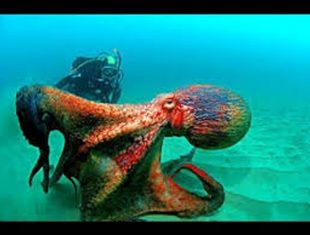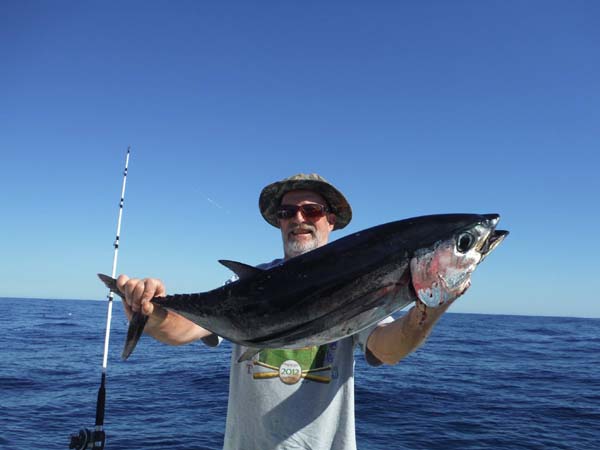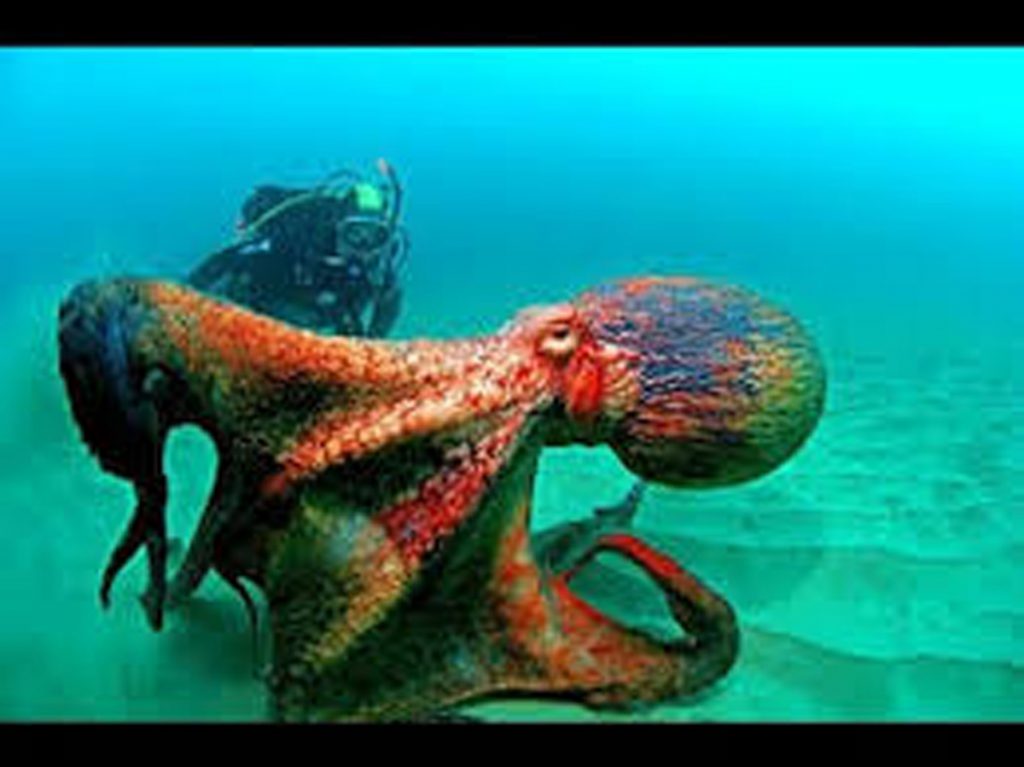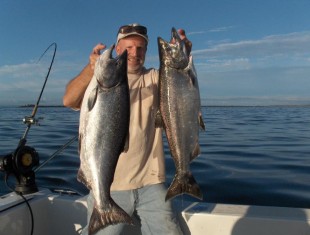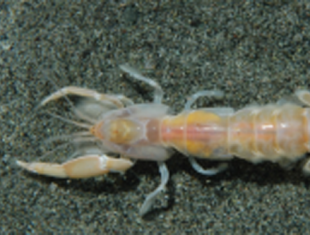EARL SANDE
GIANT PACIFIC OCTOPUS
By Earl Sande
My first encounter with a Giant Pacific octopus was more than 50 years ago while riding on a Washington State Ferry from Bremerton to Seattle. Somewhere in the middle of Puget Sound I looked out the window and saw a huge octopus near the surface. I had never seen a real one before but from recently seen pictures I knew what it was.
I have never caught one on a pole while fishing, but I know people that have. My niece Melissa Yeisley and her husband Mike and their two kids were fishing for halibut near Ketchikan last summer and caught one about 40 pounds. About an hour after it died they started cleaning it for later meals.
As they cut the arms off, the arms started crawling away as if they had a mind of their own. Octopi have a highly developed nervous system with over 500 million neurons that are found mostly in their arms.
I harvested a dozen octopus during the 1970s while scuba diving in Hood Canal. The first one I caught was the largest. About 1973 my cousin Ron Sande and I were diving off Little Dewatto Bay in 35 feet of water when we came across an eight-footer weighing about 60 pounds.
The bottom was covered with four to six- inch diameter rocks and every time we started to bring it up, the octopus would grab a few rocks making the job more difficult for us. We finally got it in the boat without getting a dangerous bite from its beak, which is venomous and can be very painful or worse.
We brought it home, cleaned and skinned it, then boiled and put it through the meat grinder which made the wonderful white meat into burger. We fried up some octopus paddies and they were absolutely delicious.
A guy I know used to be a commercial perch fisherman 40 years ago. He harvested quite a few large octopus on the Gorst mud flats near Bremerton every spring.
Male octopus die a few months after mating and females die soon after the eggs hatch that she has been guarding and caring for. For some unknown reason that area near Gorst was a place many octopus went to die.
One time Steve Thorniley and I were halibut fishing out of Port Angeles. Out in the middle of the Strait of Juan de Fuca there is a spot where an underwater mountain comes within a 100 feet of the surface. We saw lots of splashing from that spot and ran the boat over there to see what was going on. To our amazement from 20 feet away we watched a huge sea lion eating the arms off a Giant Pacific Octopus.
This octopus was really big. The sea lion would rip an arm off and scarf it down while the octopus would head back down to try and escape. But as soon as the arm was swallowed, the sea lion would swim down and bring the octopus back to the surface to rip another arm off. It was a very impressive display from two powerful sea creatures. I don’t think I need to tell you who won that battle.
There are more than 300 species of octopus. They live in most of the world’s oceans and have survived on earth for at least 100 million years. They have a family tree going back 500 million years.
The giant Pacific Octopus is the largest and lives from California to Alaska and west to Japan. They have been caught in waters 2,500 feet deep, but are usually found at 30 to 400 feet.
These giants can grow to be 350 pounds and measure 30 feet from arm tip to arm tip, but they are rarely over 100 pounds. Thirty to70 pounds would be an average weight. Their life span is usually two to five years, but since they only reproduce once, then die, I’m guessing a small percentage live longer before mating.
Octopus have eight arms and three hearts. Most females have 2,240 suckers and males have 100 fewer because one of his arms is also used as a sexual apparatus to insert sperm into the female’s mantle. The extra hearts are for passing more blood over the gills for better oxygen transfer.
An octopus beak is made of keratin, which is the same material as our fingernails. It’s the only hard part in the animal’s body except for a little cartilage around the brain, and that’s why they can get themselves through some pretty tight spaces.
An octopus first bites its prey and injects venom to paralyze it. Enzymes begin to break down the animal’s protein making it easier for the octopus to use its tongue for feeding.
They typically hide in their dens during the day and hunt at night. They love to eat crab, but will eat most shellfish and any fish it can catch. Usually they bring the dead or dying prey back to the safety of the den to eat.
The brain, sense organs and central nervous systems are the most highly developed of any invertebrate and they have highly developed eyes that are structurally similar to human eyes, but can only see in black and white. Amazingly they have a field of view of almost 360 degrees.
Females lay 30,000 to 100,000 eggs, usually in their den, and she will spend the next two to three months taking care of them by siphoning a current of water over them to keep them clean and well oxygenated.
The female doesn’t eat much during this time and dies soon after the eggs hatch. The larvae drift with the current and wind for 40 to 90 days near the surface eating anything smaller than them. By then they look like a tiny octopus and head to the bottom to kill and eat larger prey and start their fast growth. Few will survive that first year as they will be food for almost anything that swims.
When giant octopi are in their prime, they can eat four percent of their body weight and grow by two percent of their body weight every day.
In order for these intelligent and fascinating marine creatures to survive in Puget Sound they must have lots of crab and other things to eat. And females tending to their eggs must not be disturbed. Without the female taking care of those eggs few will hatch.

